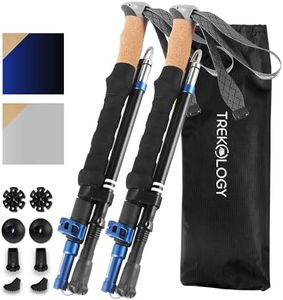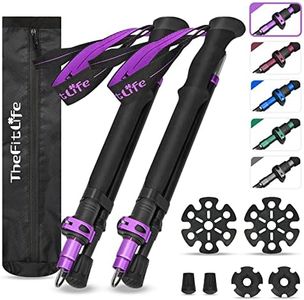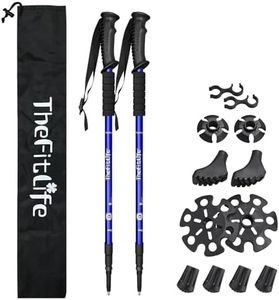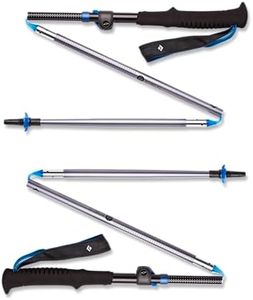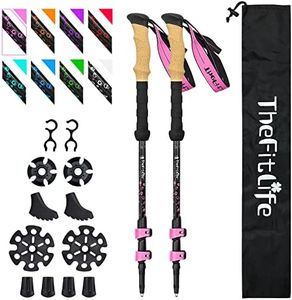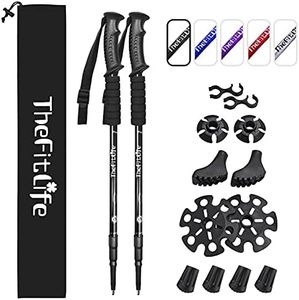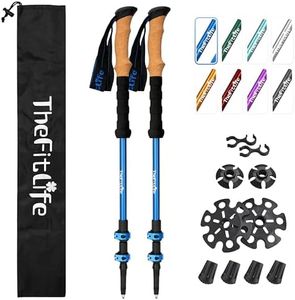We Use CookiesWe use cookies to enhance the security, performance,
functionality and for analytical and promotional activities. By continuing to browse this site you
are agreeing to our privacy policy
10 Best Hiking Sticks For Women
From leading brands and best sellers available on the web.Buying Guide for the Best Hiking Sticks For Women
Choosing the right hiking stick can make your hiking experience more comfortable, safe, and enjoyable. For women, it's important to focus on features that match your physical requirements, hiking style, and the types of trails you typically explore. The right hiking stick helps to reduce strain on joints, provides stability on uneven terrain, and can give you extra support whether you're on a leisurely walk or a challenging hike.WeightWeight refers to how heavy the hiking stick is. Lighter sticks are generally easier to handle, especially during long hikes, as they cause less fatigue. Hiking sticks can range from ultralight to heavier models. Ultralight sticks are great for extended hikes or if you want to minimize the load. Heavier sticks, while sometimes more durable, can be tiring to carry over long distances. Consider your own strength and stamina; if you prefer long treks or have joint sensitivities, a lighter stick is likely better suited for you.
AdjustabilityAdjustability describes whether and how the hiking stick can change its length. Adjustable sticks can be extended or shortened to fit your height or adapt to different terrains (for instance, shorter for uphill and longer for downhill). Some sticks are fixed-length, which can be more durable and lighter, but offer less flexibility. If you often hike on varying terrain or share the stick with others, choose an adjustable model. If your hikes are always similar and you know your ideal stick length, a fixed stick can work well.
Grip MaterialGrip material affects how comfortable the stick feels in your hand and how well it manages sweat or wet conditions. Common materials include cork, foam, and rubber. Cork grips mold to your hands over time and are good for absorbing sweat, foam grips are soft and comfortable but may wear out quicker, and rubber grips are durable and perform best in wet or cold conditions. Think about where and when you hike most; for warm climates and long hikes, cork or foam may feel more comfortable, but for rain or cold, rubber might be a better fit.
Shaft MaterialThe shaft is the main body of the hiking stick, and its material affects the weight, strength, and durability. Common options include aluminum and carbon fiber. Aluminum is sturdy, affordable, and can withstand more rough conditions, but it is a bit heavier. Carbon fiber is much lighter and absorbs shocks better, but it can be more expensive and may not handle very hard impacts as well as aluminum. If you prioritize easier carrying and reduced arm fatigue, carbon fiber might suit you, whereas aluminum wins for rugged use.
Locking MechanismThe locking mechanism determines how adjustable hiking sticks stay in place at your desired length. There are twist locks, lever locks, and some other quick-adjust systems. Lever locks are generally quicker and easier to adjust, and work well even with gloves. Twist locks are sleeker but can sometimes get stuck, especially in muddy or sandy environments. If you value quick, hassle-free adjustments, lever locks are a good choice, while twist locks might appeal if you prefer a more streamlined stick and plan to set the length and leave it.
PackabilityPackability involves how compact the hiking stick becomes when not in use, which matters if you travel or want to stow the stick in your backpack. Some sticks are collapsible into two or three sections, while others are foldable. If you anticipate needing to put the sticks away or carry them inside luggage, look for highly packable models. For local, short hikes where you know you'll use the stick the whole time, less packability may be fine.
Shock AbsorptionShock absorption is a feature that helps reduce impact on your wrists and arms, especially when going downhill. Some hiking sticks have built-in shock-absorbing springs. Models without this feature are lighter but may transmit more vibration. If you have sensitive joints or plan on a lot of downhill hiking, shock absorption can make a noticeable difference. For flat trails or if you prefer maximum simplicity and lightness, going without is also reasonable.
